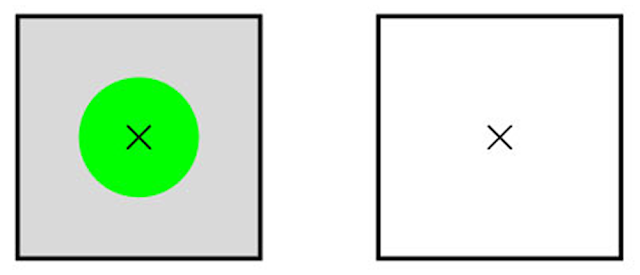In his 1927 short story “The Colour out of Space” H.P. Lovecraft describes the arrival of a strange meteorite in a small farm in Massachusetts. The bizarre object disappears shortly after crashing, but leaves behind a substance of an unknown color. Not just a strange color, but a color no one has ever seen before. This colour has terrifying effects on the surrounding area, infecting it making it hostile to human life.
Colours similar to that described by Lovecraft also exist in our real world. While they do not have any paranormal property, they are still considered “impossible”. Let’s see Colours are byproducts of light, in the form of electromagnetic radiation. Light is composed of many different wavelengths. When it hits an object, some wavelengths are absorbed by it, while others are reflected. These reflected wavelengths then reach our eye, where they interact with the so-called “cone cells”. This small, cone shaped cells are divided into three categories: S, L and M. Each category can perceive different wavelengths: S perceive Short wavelengths, blue and violet. L perceive Long wavelengths, red and yellow. M perceive Medium wavelengths, green.
All the colors that we can perceive are the result of the combined stimuli of these three types of cells. Above this paragraph is the “CIE 1931 Colour Space”, a diagram that shows all existing colours. The black line that surrounds the majority of the figure is the “Spectral Line”. All colors alongside this line are therefore called “Spectral Colours”. They can be perceived using only one type of cone cells. Those at the bottom instead are the “Purples”. These are colors like purple, pink and magenta. They can be perceived only using two or more types of cone cells.
Outside of the figure are the “Impossible Colours”. Those are colouurs that we cannot perceive, because we lack the necessary organs. But we know that they exist, because there are wavelengths that can be associated to them. And animals that possess more cone cells than us, are able to see them in the form of new colors. Colours that, for us, are impossible. Birds, for example, possess four types of cone cells. Butterflies have five. Mantis shrimps, a species of tropical shrimps, have twenty.
But, in spite of this, there’s actually a way for us to see some of this colors. When we stare at a color for too long, our cone cells become fatigued. This leaves an afterimage in our perception that remains even if we then look at something else. If used in the right way, this process allows us to see the “Chimerical colors”, temporarily perceivable impossible colors.
Chimerical colors are divided into three categories. “Stygian Colors” are impossibly dark colours. Stygian blue, for example, is darker than the darkest possible blue. “Self-luminous Colors” are impossibly bright instead. So bright, that they seem to glow. Self-luminous red, for example, is a red so bright that looks brighter than white. Finally “Hyperbolic Colours” have an impossibly high saturation. Hyperbolic orange is so saturated that it looks purer than the purest achievable shade of orange.
If you want to try to see these colours, then look at the images below. Pick one. First you need to stare at the cross on the left for around 20-30 seconds. Then quickly look at the cross on the right. You should be able to see a colour for a short period of time. That’s a chimerical colour.
If you want you can continue trying to see the chimerical colours. Just remember to wait at least a minute or two between every attempt. Taking care of one’s eyes is important!
YURI, 4sc






No comments:
Post a Comment